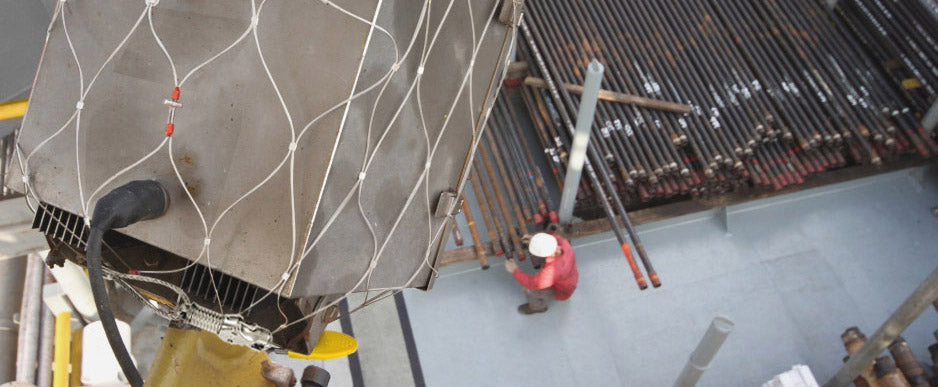Drops risks continually evolve, and so too must prevention systems. Enter the new Dropsafe Net, an enhanced version of Dropsafe’s original, industry-leading secondary retention device. By adding the triple action, auto locking Trisafe™ Carabiner and in-built RFID chip, Dropsafe has built on its Nets’ industry-leading standards of safety and security. We sat down with Mike Rice to discuss why these innovations are so important and how the industry is ready for the next evolution in secondary retention technology.
Hi Mike! Thanks for talking to us today. To begin, could you outline the role that nets play in keeping personnel safe? What risks does this solution tackle?
The widespread use of steel-wire nets to enclose and tether overhead fixtures across all industries, especially offshore oil and gas (O&G), is no coincidence. Dropsafe were the pioneers, designing and manufacturing the first steel-wire nets on the market. The product was developed in close collaboration with the industry to help mitigate Drops incidents, which present a particular challenge in offshore environments.
Many fixtures, including lighting, speakers, and cameras can come loose and fall due to corrosion or loosening of the primary attaching point, incorrect installation, or impacts – potentially striking and injuring personnel.
There is no substitute for a purpose designed secondary retention net, both in terms of ease of installation and effectiveness. Slings and other makeshift solutions, or poorly designed counterfeit nets, are not fit for purpose and may compromise the safety of an asset. A well-engineered net will contain the Drops incident and prevent further damage or injury.
Where does Dropsafe fit into this picture?
Dropsafe has supplied the Dropsafe Net to over 300 leading O&G businesses worldwide. The solution has become an O&G industry standard, saving lives offshore for over a decade.
The Dropsafe Net has now become the accepted best practice method for secondary securing across a wide variety of applications in diverse industrial sectors. This is due to the extensive third-party testing of each model, the versatility of its robust, tried-and-tested design, and its quick, tool-free installation.
To ensure that the Dropsafe Net continues to meet the needs of operators in a range of operational environments, it has continually undergone R&D. We set the industry benchmark, and now we are raising it.
Could you give some insight into the latest developments in secondary securing technology?
A common challenge that O&G operators have faced is the use of carabiners as the primary method for securing nets, or tool tethers. These carabiners are a vital component, but their fundamental design is flawed and their long-term efficacy is at risk from poor quality manufacture, their misuse, or human error.
Reverse snagging by wires, vibration and failure by operators to tighten the screw lock, can lead to the carabiner opening, reducing the effectiveness of the overall solution. Equally, the use of poorly manufactured, traditional carabiners for offshore Drops prevention further risks compromising safety.
It sounds like this crucial component needs a rethink. What has Dropsafe been doing to deliver a safer, more user-friendly, and more durable solution?
Dropsafe has been working with key players in the offshore industry to develop the Dropsafe Trisafe™ Carabiner, which is the market’s first true triple-action, auto-locking carabiner. It adds a new layer of security, reducing human error and making it easier to be safer. Crucially, it can be operated effectively single-handedly.
Made completely of AISI/SUS 316 stainless steel, it has been tested to ten times over its safe working load of 80kg. The Trisafe™ also has an integrated design to prevent disassembly or loosening.
What other enhanced features do the new Nets have?
The updated Dropsafe Choke Plate, specifically designed to fit the Trisafe Carabiner, includes an embedded RFID chip. This enables authentication, equipment tracking and full traceability.
The Net’s RFID chip unlocks a new level of digital integration, enabling trackable, digital monitoring of the solution during inspections and easy assimilation into data-based safety management systems.
What are the Dropsafe Trisafe™ Carabiner’s benefits?
At the outset of redesigning a bespoke and evolved carabiner, our engineers considered the fundamentals: what is a carabiner trying to achieve?
Starting at this point led us to consider how we could bring to market a new type of carabiner locking mechanism that could be used not only for the new Dropsafe Net, but for a wider range of applications. This has delivered a solution with the following features:
• More versatile, but more secure
• Requires a simple, failsafe three-step sequence to open
• True auto-locking mechanism
• Reduces the opportunity for human error
• Intuitive single-handed mechanism
The high-strength spring enables the mechanism to snap back into place, auto-locking the device and ensuring a secure installation onto the wire with significantly reduced scope for human error.
How does the design of the new carabiner tackle some of the challenges faced by personnel on site?
Traditional carabiners are inadequate for the harsh environments O&G rigs and drillships can experience. The design of carabiners has not reflected the realities faced by technicians offshore.
For example, personnel may wear protective gloves as part of their PPE. In colder climates, such as the North Sea, these gloves will be thicker. This reduces manual dexterity, and with fiddly, tight screws, locking and unlocking the carabiner multiple times can quickly become frustrating.
Or imagine a technician hanging from a rope to install a net on a raised fixture. It’s windy. The rope is swinging. They can only use one hand. But they still have to screw the carabiner closed regardless.
The Dropsafe Trisafe™ Carabiner eliminates these issues and ensures that staying safe offshore is simpler than ever.
Thanks for the conversation, Mike – we look forward to hearing more exciting news from Dropsafe’s R&D department soon!
Want to find out more? Read more on the product page.
If you have any questions about how Dropsafe can support your Drops prevention programmes with solutions such as the new Dropsafe Nets, you can contact us at info@dropsafe.com

